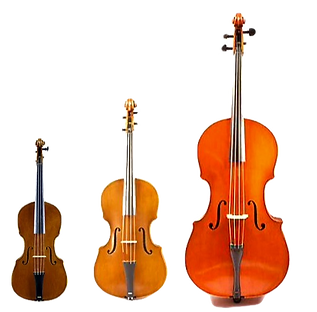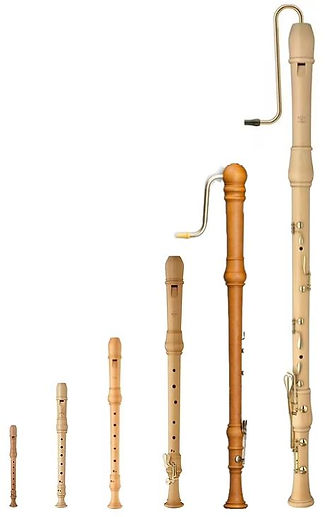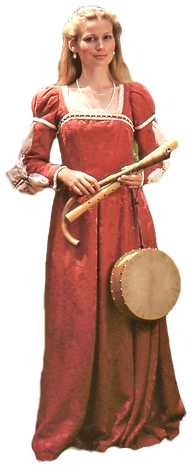Andrew Huggett Ottawa Manotick Citizen
INSTRUMENTS PLAYED BY THE HUGGETT FAMILY
MUSICAL INSTRUMENTS
THE MAKERS
Audiences were always fascinated by the wide variety of instruments played by the Huggetts and often asked about their origins. All the Huggett's period instruments were authentic reproductions made by various European craftspeople. Primarily, the winds were made in Germany by Körber and Moeck. Over the years, the latter company has established itself as one of the world's leading recorder manufacturers.
Many of the Huggett's stringed instruments were made by young luthiers at the beginning of their careers. Leslie would commission several instruments at a time, which aided them in getting established. This also allowed the family to acquire the instruments they needed at an affordable cost. Over the years, the Huggetts invested significantly in many young makers who became world famous in their field.
Robert Bailey, John Pringle, Bryan Maynard, and Philip MacLeod-coupe are some of the makers that the Huggetts supported. A complete list follows at the bottom of this page.
_jfif.jpg)
Philip MacLeod-coupe, British luthier.

Robert Bailey, viol maker. The Huggetts supported many period instrument makers early in their careers.

John Pringle, proud father, surrounded by a group of his viols. John also made many of the Huggett's instruments.



BOWED INSTRUMENTS
Viol and Viola da Gamba
The viol is a flat-backed, six-stringed, bowed, and fretted instrument. It first appeared in Spain in the mid-to-late 15th century and was popular throughout Europe during the 16th, 17th, and 18th centuries. It is tuned in 4ths, with one interval of a major third, similar to the modern guitar. The bow is held "underhand," unlike modern bows, which are held "overhand." The instrument comes in various sizes and pitches, the most common being treble, tenor, and bass. All sizes are held between the legs, much like the modern cello. The viol family is used in consort work, with three to six viols of different sizes playing together. The bass viol, or viola da gamba (viol of the leg), is often used as a solo instrument and as bass support in continuo playing. The Huggetts owned 11 viols of various sizes.
The viols were played by all the Huggetts.
_edited_edited.png)
Treble, tenor, and bass viol (also called viola da gamba)

Underhand.

Overhand

Modern and Baroque Violin, Viola and Cello
The Huggetts played both the Baroque and modern members of the violin family - the violin, viola, and cello. To the casual observer, the instruments look identical. Indeed, the most sought-after names in the modern world, Stradivarius, Amati, etc., started as baroque instruments that have since been modernized to suit contemporary ideals.
The primary differences between modern and period instruments are:
-
Steel for some of the modern instrument's strings, all gut strings on the old.
-
A thicker bass bar in the modern instrument, a lighter bass bar in the old.
-
A greater angle in the neck of the modern instrument, a shallow angle in the neck of the old;
-
a difference in the shape and weight distribution of the bows used to play the instruments.
The tonal result of these differences is a louder sound from a modern instrument and a softer, sweeter sound from the old. The Huggetts owned 2 cellos, 2 violas, and 4 violins. All violin family members are played holding the bow "overhand."
Fiona played the violin, Ian and Andrew played the violin and viola, and Jennifer played the cello.
Fiona played the violin, Ian and Andrew played the violin, and viola and Jennifer played the cello. Fiona and Jennifer still play professionally today.

Violin, viola and cello.

The modern bow.

A Barouque Bow.

PLUCKED INSTRUMENTS
Lute
The lute descends from the oud, which was introduced into Europe by knights returning from the Holy wars and was used to add harmony and texture to vocal and instrumental secular music from the Medieval to the late Baroque periods. It was also a favored solo instrument for which numerous works were written by famous composers like Holborn, Morley, and Dowland.
The bent neck of the lute makes the instrument more compact and suitable for playing in tight spaces. The lute's highest string is single. The rest of the instrument is double-strung in "courses," tuned in unisons or octaves. The early lute had four or five courses, but the number of courses grew over time. By the end of the Renaissance, the number of courses had grown to ten. During the Baroque era, the number continued to increase until it reached as many as 19. These instruments had up to 35 strings which made tuning a real challenge.
The lute presents several challenges to the player. The double strings and short wide neck often make complex chords physically challenging, and its soft sound is hard to hear in larger rooms. Though soft in its solo capacity, the lute adds fullness when used in conjunction with members of the viol family.
Andrew was the family lutenist and played a 15-string eight-course tenor lute.

A Renaissance eight course tenor lute.

Guitar
The guitar is arguably the most successful instrument on the planet. Its affordability, easy initial learning curve, and extraordinary versatility have made it a popular choice in all genres of music, from classical and jazz to modern pop.
Though they are similar, the lute and guitar have different beginnings. Midway through the 16th century, the five-course guitar was popular in Spain. A literary source, Lope de Vega's Dorotea, credits Spanish poet and musician Vicente Espinel for its invention. For the next 200 years, the "Spanish" guitar went through many changes as various makers worked to improve its tone and playability. Around 1850, the proportions and structure of the modern classical guitar were established by Antonio Torres Jurado. He significantly improved the volume, tone, and projection of the instrument, which has remained essentially unchanged since.
The Huggett Family used nylon, steel, 12-string, and occasionally bass guitar in their folk songs. Margaret and Andrew both played the guitars.

Classical, steel 6-string, 12-string and bass guitars

KEYBOARD INSTRUMENTS
Harpsichord, Virginal, Spinet & Piano
Before the Huggett Family, Margaret was a pianist and clarinetist. She did not play the clarinet in the Huggett Family but occasionally played the piano in some of their early folk songs. She played the virginal, harpsichord, and spinet in the Huggett Family ensemble.
Pianos and harpsichords sound very different. A felt hammer is propelled upwards when a piano key is struck, striking and bouncing off the piano's string. A piano can produce a wide range of dynamics, from very soft to very loud. It has a sustaining pedal that allows the note to ring on after the finger releases the key. When a harpsichord key is struck, it levers up a wooden post with a small quill

Virginal, grand piano, harpsichord and spinet.
plectrum mounted to its side, plucking one or more strings. It can't play loud and soft and has no sustain pedal, so the note stops as soon as the finger is lifted. The spinet is a smaller version of the harpsichord and was a popular instrument in the courtiers' chambers. The more travelable viginal has stings that run parallel to the keyboard and are, therefore, struck at a different spot along the length of the string, giving it a rounder sound. All three instruments were used in Renaissance and Baroque music. During the Baroque era, the harpsichord and viola da gamba were a standard combination for the playing of basso continuo, which was the foundation for accompanying solo instruments. Much solo music also was written for the three members of the harpsichord family. During the late 18th century, following the development of the fortepiano, the harpsichord gradually disappeared from the music scene.

WIND INSTRUMENTS
Renaissance & Baroque Recorders, Gems Horn
The recorders are a family of instruments known as internal duct flutes, flutes with whistle mouthpieces. They are made in various sizes with names and compasses roughly corresponding to various vocal ranges, soprano, alto, tenor, and bass. They are traditionally constructed from wood or ivory. School recorders are commonly made of molded plastic. The recorders played by the Huggett Family fell into two categories: Renaissance and Baroque. Renaissance recorders have a somewhat cylindrical bore, giving them a richer sound but reduced range. Baroque recorders have an upside-down conical bore resulting in a thinner sound but more rage and chromatic capability.
The recorder first appeared in Europe in the Middle Ages and enjoyed wide popularity in the Renaissance and Baroque periods. It was little used in the Classical and Romantic periods. However, it was revived in the 20th century as part of the Early Music movement and became a popular amateur and educational instrument. Monteverdi, Lully, Purcell, Handel, Vivaldi, Telemann, Bach, Hindemith, and Gordon Jacob wrote for the recorder.
The Gems Horn is also a duct flute. It is made from a goat or other suitable horn and has a pleasing round, breathy sound but minimal range and chromatic flexibility.




Gems Horn
Great bass, bass, tenor, alto, soprano, sopranino, and piccolo Renaissance recorders.
Sopranino, soprano, alto, tenor, bass, and great bass Baroque recorders.
Many people are surprised by the size of some recorders, as can be seen here using this proportional picture of Jennifer.
Baroque Flute
During the Renaissance, the recorder, with its louder sound, was generally preferred over the early flute with its cylindrical bore. However, by the Baroque period the instrument had been significantly redesigned. It had three or four sections or "joints" and a conical bore, giving it a wider range and more penetrating sound without sacrificing its softer, expressive qualities. There is one key on the baroque flute on the foot joint.
Baroque composers also changed the role of the flute, and with the onset of the Baroque era, the flute began to take on a role as a solo instrument.
Praetorius, Schütz, Rebillé, Quantz, J.S Bach, Telemann, Blavet, Vivaldi, Hotteterre, Handel, and Frederick the Great all composed for the Baroque Flute.
Jennifer and Leslie played the Baroque flute.

Baroque flute.
Krummhorn
The krummhorn is a wooden wind-capped reed instrument. A double reed is mounted inside a cap, and blowing through a slot in the cap produces a musical note. The instrument's origin is in the bladder pipe and the bagpipe chanter. One unusual feature of the krummhorn is its shape; the end is bent upwards in a curve resembling the letter 'J.' This curve makes for a more compact instrument but does not influence the sound.
Krummhorns have a cylindrical bore and are quieter than their conical-bore relatives, the rauschpfeife and shawm. They have a limited range, usually a ninth. Krummhorns have a characteristically sharp attack which is very effective in ensemble work. Depending on how their reeds are voiced, they range in tone from a gentle, somewhat nasal humming to a rich, resonant buzzing.
The name krummhorn comes from the German for bent horn. The instrument was popular in the 14th to17th centuries in Europe. King Henry the Eighth of England owned 25 Krummhorns, but they were most popular on the continent, from where a small repertoire of music specifically for krummhorns has been preserved.
All the Huggetts played the krummhorn.
There is a double reed under the cap of all "wind-capped" instruments.

Bass, tenor, alto and soprano krummhorns..

Rauschpfeife
Rauschpfeife is another member of the wind-capped family popular in 16th and 17th century Europe. It differs from the krummhorn in the shape of the bore, which is conical. This bore profile, combined with the free vibration of the reed within the wind cap, produced an exceedingly loud instrument, making it useful for outdoor performances.
Rauschpfeife is German for "rush (or reed) pipe."
Leslie and Andrew both played the rauschpfeife.

Rauschpfeife
Shawm, Baroque Modern Oboe.
The shawm was another instrument introduced into Europe in the 13th century by returning crusaders. It is a double reed instrument and is still played in many parts of North Africa, the Middle East, and the Far East. It comes in various sizes, though the Huggetts only used the tenor in their music.
In Europe, by the 17th century, the instrument had been modified into the hautbois, which is French for "high wood." Today it's more commonly called the Baroque oboe. As with all early woodwind instruments, keys have been gradually added over time to increase range and help the player play faster and with better tuning.
The standard Baroque oboe is generally made of boxwood. It has three keys: a "great" key and two side keys (the side key is often doubled to facilitate the use of either the right or left hand on the bottom holes). To produce higher pitches, the player has to "overblow" or increase the air stream to reach the next harmonic.
Purcell, Albinoni, Bach, Handel, Alessandro Marcello, Telemann (who played the instrument), and Vivaldi wrote music for the Baroque oboe.
Andrew played the shawm and oboes.



Shawm, Baroque oboe and modern oboe.
The Rackett
The first historical mention of the rackett is found in the 16thg century.
There were four sizes of rackett; soprano, tenor-alto, bass, and great bass. Relative to its pitch, the rankett is relatively small. The soprano is only 4½ inches long. This is achieved through ingenious construction. The body consists of a solid wooden cylinder into which nine parallel bores are drilled. These are connected alternately at the top and bottom, resulting in a long, cylindrical wind passage within a compact body.
The result is a pocket-sized instrument that will descend as low in pitch as a modern bassoon. This unique construction earned it the nickname "sausage bassoon."
To play the rackett, the hands are placed side by side. Additional holes are covered by the thumbs and the second joint of the index finger to extend the range.
Despite its quirks, the rankett is a versatile instrument with a wide range of notes and dynamics. With an appropriate reed, the baroque rankett has a similar chromatic range to the baroque bassoon and can perform most bass-instrument repertoire.
Leslie played the bass rackett

Bass Rackett
.png)
THE HUMAN VOICE
The church teaches that humans, and the human voice, were created after God. For much of the Medieval and Renaissance periods, vocal music was the only form of music allowed in church.
Outside the church, musicians strove to imitate the voice both compositionally and in their playing, irrespective of their chosen instruments' natural character. Over 300 years, instruments gradually started to appear in religious music. However, ill-suited to mimicking the human voice, the lute and guitar found themselves relegated to the secular domain.
Regardless of one's religious beliefs, the human voice, with its unequaled ability to communicate words, music, and emotion, remains the undisputed champion of the music world. Most "stars" in all genres of music are singers, and it's only natural that, as humans, we find singers the easiest of all musicians with whom to connect.
Renaissance and folk music were written to be sung by ordinary people. Though none of the Huggetts were blessed with an extraordinary voice, the group was able to perform in both genres with notable success. Their performances of madrigals and secular Christmas songs, often performed a cappella, drew praise from audiences and critics alike.
Jennifer, Ian, and Fiona had soprano voices. Margaret sang alto, Andrew tenor and Leslie bass.
